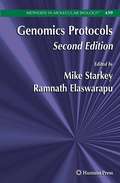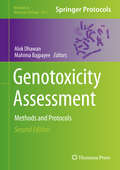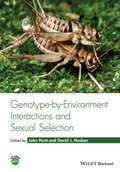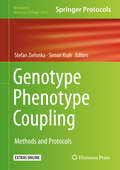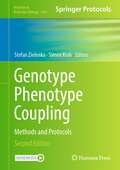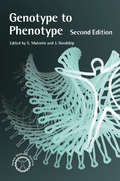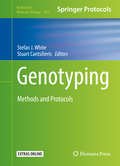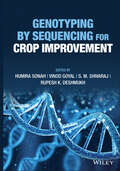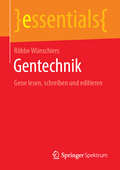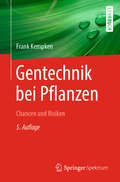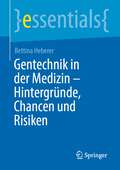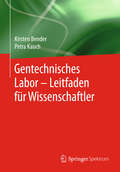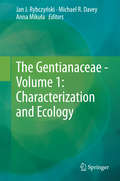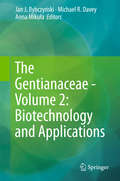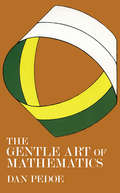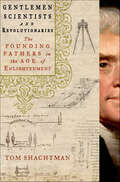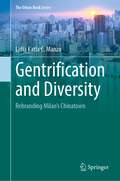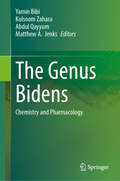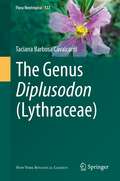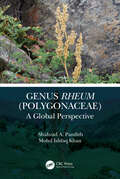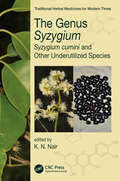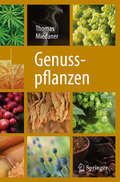- Table View
- List View
Genomics Protocols
by Ramnath Elaswarapu Mike StarkeySince the first edition, published in 2001, genomics research has taken great strides. In this updated second edition, a team of expert researchers share the most current information in a field that has recently switched emphasis from gene identification to functional genomics and the characterization of genes and gene products. This volume approaches its subject with a broad perspective to supply its reader with a vital overview of genomics and its derivative fields.
Genotoxicity Assessment: Methods and Protocols (Methods in Molecular Biology #2031)
by Alok Dhawan Mahima BajpayeeThis current edition explores new tests for genotoxicity testing, along with other well-known techniques. This will further help in our understanding of the genotoxic effects of chemicals. The book has different sections dealing with various assays for gene mutation, chromosomal abnormalities, primary DNA damage, etc. It also delves into plant models, animals and their alternates, as well as in silico approaches for genetic toxicology. Written for the highly successful Methods in Molecular Biology series, chapters include introductions to their respective topics, lists of the necessary materials and reagents, step-by-step, readily reproducible laboratory protocols, tips on troubleshooting and avoiding known pitfalls. Authoritative and up-to-date, Genotoxicity Assessment: Methods and Protocols, Second Edition serves as a highly useful and ready resource for research students and scientists working in regulatory toxicology as well as biomedical, biochemical, and pharmaceutical sciences.
Genotype-by-Environment Interactions and Sexual Selection
by John Hunt David J. HoskenSexual selection is recognized as being responsible for some of the most extravagant morphologies and behaviors in the natural world, as well as a driver of some of the most rapid evolution. While Charles Darwin's theory is now a fundamental component of modern evolutionary biology, the impact of genotype-by-environment interactions on sexual selection has thus far received little attention.This book represents the first comprehensive analysis of the role genotype-by-environment interactions play in sexual selection and the potential implications that they have for the evolutionary process. The Editors have identified 13 topics that currently define the field and shed light on the impacts of these interactions on sexual selection. This includes key topics, such as resolving the lek paradox and how genotype-by-environmental interactions can compromise the honesty of sexual signals. The volume also outlines key questions that remain unanswered and provides a comprehensive guide to analyzing genotype-by-environment interactions.The mix of theory, empirical studies, and practical instructions from world leading experts make this book a particularly potent and definitive guide on the topic. It will be of interest to evolutionary biologists, spanning from genomicists to behaviorists."This is a very timely book, covering a topic that should change the way we think about sexual selection. The contributors are all leaders and the topics should provide guidance to many PhD projects in the years to come. GEI is increasingly shown to be important, and it seems likely that it is critical in species where sexual selection is operating. This book is likely to help revitalize the study of sexual selection." Professor Allen Moore, The University of Georgia"GEIs fascinate evolutionary biologists, but the unique consequences for sexually selected traits have been neglected - until now. This multi-authored book comprehensively explains key theoretical concepts, handles practical 'how to' issues and uses classic case studies to illustrate the value of studying GEIs. It is a must read for everyone interested in sexual selection." Professor Michael Jennions, The Australian National University
Genotype Phenotype Coupling: Methods and Protocols (Methods in Molecular Biology #2070)
by Stefan Zielonka Simon KrahThis volume aims at providing state-of-the-art protocols detailing ribosome display, cDNA display, phage display, yeast surface display, and mammalian display. Chapters guide readers through methods and protocols on in vitro methods over prokaryotic display systems, lower eukaryotes, and mammalian cells. Written in the highly successful Methods in Molecular Biology series format, chapters include introductions to their respective topics, lists of all necessary materials and reagents, step-by-step, readily reproducible laboratory protocols, and key tips on troubleshooting and avoiding known pitfalls. Authoritative and cutting-edge, Genotype Phenotype Coupling aims to provide an overview of current technologies in this exciting and continuously evolving field.
Genotype Phenotype Coupling: Methods and Protocols (Methods in Molecular Biology #2681)
by Stefan Zielonka Simon KrahThis detailed new edition broadens the scope of the first edition by moving beyond classical display technologies. This book explores methodologies for the generation of natively paired antibody libraries, single cell technologies, alternative scaffolds, and in silico antibody sequence assessments are described. The application of these methods may allow for a generation of improved therapeutics and diagnostic reagents in a shorter time frame. Written for the highly successful Methods in Molecular Biology series, chapters include introductions to their respective topics, lists of the necessary materials and reagents, step-by-step and readily reproducible laboratory protocols, and tips on troubleshooting and avoiding known pitfalls. Authoritative and practical, Genotype Phenotype Coupling: Methods and Protocols, Second Edition serves as an ideal guide for researchers seeking to expand their knowledge of antibody-based therapeutics.
Genotype to Phenotype
by S.Malcolm and J.GoodshipThis new edition builds on the success of the first by reviewing the increased understanding of the mechanisms of gene action in humans, focusing particularly on those derived from the study of genetic diseases. It deals mainly with the fundamental aspects of gene arrangement and expression rather than mutation. As well as updating and revising material from the first edition, it covers methods of exploring gene function and contains a range of chapters on specific systems which raise issues of special interest such as imprinting or homologous genes within clusters.
Genotyping
by Stefan J. White Stuart CantsilierisThis volume explores a broad range of different genotyping techniques. Genotyping: Methods and Protocols consists of chapters that cover numerous topics such as: an overview of multiplexed microsatellite analysis; High Resolution Melt analysis and TaqMan-based assays; in situ analysis of variants in single RNA molecules; the MassARRAY system and Molecular Inversion Probes; Pulsed Field Gel Electrophoresis, Paralogue Ratio Test, and Multiplex Ligation-Dependent Probe Amplification; long-range PCR combined with PacBio sequencing; Targeted Locus Amplification; Multilocus Sequence Typing and rapid SNP detection with pyrosequencing; and genotyping-by-sequencing for plant analysis. Finally, the volume concludes with a summary of pertinent points to describe genetic variation. Written in the highly successful Methods in Molecular Biology series format, chapters include introductions to their respective topics, lists of the necessary materials and reagents, step-by-step, readily reproducible laboratory protocols, and tips on troubleshooting and avoiding known pitfalls. Thorough and practical, Genotyping: Methods and Protocols is a valuable resource for anyone interested in learning more about the diverse field of genotyping.
Genotyping by Sequencing for Crop Improvement
by Humira Sonah Vinod Goyal S. M. Shivaraj Rupesh K. DeshmukhOGENOTYPING BY SEQUENCING FOR CROP IMPROVEMENT A thoroughly up-to-date exploration of genotyping-by-sequencing technologies and related methods in plant science In Genotyping by Sequencing for Crop Improvement, a team of distinguished researchers delivers an in-depth and current exploration of the latest advances in genotyping-by-sequencing (GBS) methods, the statistical approaches used to analyze GBS data, and its applications, including quantitative trait loci (QTL) mapping, genome-wide association studies (GWAS), and genomic selection (GS) in crop improvement. This edited volume includes insightful contributions on a variety of relevant topics, like advanced molecular markers, high-throughput genotyping platforms, whole genome resequencing, QTL mapping with advanced mapping populations, analytical pipelines for GBS analysis, and more. The distinguished contributors explore traditional and advanced markers used in plant genotyping in extensive detail, and advanced genotyping platforms that cater to unique research purposes are discussed, as is the whole-genome resequencing (WGR) methodology. The included chapters also examine the applications of these technologies in several different crop categories, including cereals, pulses, oilseeds, and commercial crops. Genotyping by Sequencing for Crop Improvement also offers: A thorough introduction to molecular marker techniques and recent advancements in the technology Comprehensive explorations of the genotyping of seeds while preserving their viability, as well as advances in genomic selection Practical discussions of opportunities and challenges relating to high throughput genotyping in polyploid crops In-depth examinations of recent advances and applications of GBS, GWAS, and GS in cereals, pulses, oilseeds, millets, and commercial crops Perfect for practicing plant scientists with an interest in genotyping-by-sequencing technology, Genotyping by Sequencing for Crop Improvement will also earn a place in the libraries of researchers and students seeking a one-stop reference on the foundational aspects of – and recent advances in – genotyping-by-sequencing, genome-wide association studies, and genomic selection.
Gentechnik: Gene lesen, schreiben und editieren (essentials)
by Röbbe WünschiersDieses essential soll als Einführung für eine zeitgemäße öffentliche Diskussion zur Gentechnologie dienen. Die Gentechnik betrifft uns alle in vielen Bereichen und wir müssen uns trauen, bunter und weiter zu denken. Tatsächlich kann bereits das komplette Erbgut von Viren und Bakterien chemisch erzeugt und „zum Leben erweckt“ werden. Mit der Genchirurgie ist die Medizin an einem Scheidepunkt: Wollen wir Erbkrankheiten therapieren oder genetisch „reparieren“? Und die Analyse tausender menschlicher Erbgute fördert Informationen zutage, die mit komplexen Krankheiten, aber auch Merkmalen wie Intelligenz in Verbindung stehen. Wie sollen wir dieses Wissen nutzen? Es stellt sich kaum noch die Frage, ob wir Gentechnik wollen, sondern vielmehr, wie wir sie anwenden.
Gentechnik bei Pflanzen: Chancen und Risiken (Springer-lehrbuch Ser.)
by Frank KempkenBieten gentechnisch veränderte Pflanzen eine Zukunftsperspektive? Kompetent und auf dem neuesten Erkenntnisstand geben die Autoren einen Überblick über die Chancen und Risiken der pflanzlichen Gentechnik: Methoden, Verfahren zur Erzeugung und Identifizierung transgener Pflanzen, Anwendungsbeispiele sowie Freisetzungsversuche und Fragen der Kommerzialisierung. Der Band enthält Boxen mit Hintergrundinformationen, einprägsame Kernaussagen sowie ein umfangreiches Glossar. In der Neuauflage sind alle Abbildungen farbig, alle Kapitel wurden aktualisiert.
Gentechnik in der Medizin – Hintergründe, Chancen und Risiken (essentials)
by Bettina HebererBettina Heberer gibt interessierten Laien einen Einblick in die Verwendung von Gentechnik in der Medizin. Die Autorin erläutert die verschiedenen Anwendungsbereiche der Gendiagnostik und Gentherapie. Zugelassene sowie potentielle zukünftige Therapiemöglichkeiten werden ebenso behandelt wie rechtliche Grundlagen. Eine Diskussion der Chancen und Risiken, die mit der Entwicklung neuer Technologien einhergehen, runden das Werk ab.
Gentechnisches Labor – Leitfaden für Wissenschaftler
by Kirsten Bender Petra KauchDieses Buch liefert Ihnen einen umfassenden und praxisnahen Überblick zu Fragen zum Gentechnikgesetz und seiner Rechtsverordnungen im Laboralltag. Ob Transformation bei Bakterien oder virale Gentransfermethoden bei höheren Zellen, die Kenntnis der rechtlichen Rahmenbedingungen und der Sicherheit in den Labors spielt bei allen angewandten Methoden die wichtigste Voraussetzung. Diese werden in Deutschland im Wesentlichen durch das Gentechnikgesetz und die Gentechnik-Sicherheitsverordnung gewährleistet. Worauf muss in der täglichen Praxis in einem „Genlabor“ geachtet werden? Wann haben Studenten, Doktoranden, technischen Mitarbeiter oder der Laborleiter die Verantwortung? Das neue Kompendium „Gentechnisches Labor - Leitfaden für Wissenschaftler“ unterstützt Studierende, Doktoranden, Wissenschaftler und Praktiker, aber auch die Laborleitung und den Betreiber in der Industrie bei der Anwendung der rechtlichen Vorgaben. Die wichtigsten gesetzlichen Vorgaben werden ausführlich einschließlich aktueller Bewertungen der ZKBS und aktueller Rechtsprechung dargestellt.
The Gentianaceae - Volume 1: Characterization and Ecology
by Jan J. Rybczyński Michael R. Davey Anna MikułaThis is the first of two volumes on Gentianaceae. Comprising twelve chapters, it centres upon the characterization and ecology of Gentianaceae worldwide, with emphasis on the application of molecular and cytological approaches in relation to taxonomy. The first three chapters consider the classification of the family and review the advances in research since the earlier revision published in 2002, which resulted in the reclassification of some plants and the naming of new genera. The next chapter provides the most comprehensive report to date of the systematics of South American Neotropical woody Gentians. Other reviews include details of the Gentianaceae in Eastern Europe. The key biochemical steps that result in the diversity of Gentian flower colors, the cytology of European species and an historical account of the importance of Gentians in herbal medicines are also covered. Furthermore, an analysis of gene expression in overwintering buds is presented, discussing several aspects of plant taxonomy, phenotypic characteristics, phylogeography and pedigree. Two contributions highlight the importance of Gentians in India, and the last chapter presents evidence for the importance of Glomeromycota in developing arbuscular mycorrhizal associations with the roots of Gentians. This volume provides the basis for the biotechnological approaches that are considered in the companion book The Gentianaceae - Volume 2: Biotechnology and Applications.
The Gentianaceae - Volume 2: Biotechnology and Applications
by Jan J. Rybczyński Michael R. Davey Anna MikułaThis book, the second of two volumes on the Gentianaceae, is devoted to aspects of biotechnology and their applications. It consists of 18 chapters and covers micropropagation by means of organogenesis or somatic embryogenesis, and single cell manipulation of various species belonging to the horticultural genera Blakstonia, Centaurium, Gentiana, Gentianalla and Swertia. Furthermore, the application of somatic cell hybridization, haploidization and genetic variation arising from tissue and organ culture for the production of plants with new horticultural traits, such as new flower colors or sizes, or with special pharmaceutical values, is treated in detail. Also discussed are molecular markers that facilitate breeding and cultivar identification, the preservation of genetic resources by cryopreservation, the postharvest physiology of cut Gentian flowers and potted plants, and different analytical methods for the evaluation of Gentians as sources of secondary metabolites, such as xanthones and flavonoids, secoiridoids and C-glucoflavonoids, and their positive impacts on human health. This volume as well as the companion book The Gentianaceae - Volume 1: Characterization and Ecology will serve as key reference works for scientists and students in the fields of botany, plant breeding, biotechnology and horticulture, as well as professional gardeners.
The Gentle Art of Mathematics
by Dan PedoeMathematical games, probability, the question of infinity, topology, how the laws of algebra work, problems of irrational numbers, and more. 42 figures.
Gentlemen Scientists and Revolutionaries: The Founding Fathers in the Age of Enlightenment
by Tom ShachtmanScience and experimentation were at the heart of the Founding Fathers' philosophies and actions. The Founders relentlessly tinkered, invented, farmed by means of scientific principles, star-gazed, were fascinated by math, used scientific analogies and scientific thinking in their political writing, and fell in love with technologies. They conceived of the United States of America as a grand "experiment" in the scientific meaning of the word. George Washington's embrace of an experimental vaccination for smallpox saved the American army in 1777. He was also considered the most scientific farmer in the country. John Adams founded a scientific society and wrote public support of science into the Massachusetts constitution. The president of another scientific society, Thomas Jefferson, convinced its leading lights to train Meriwether Lewis for the Lewis and Clark expedition; his Declaration of Independence was so suffused with scientific thinking that it was called Newtonian. Benjamin Franklin's fame as an "electrician" gave him the status to persuade France to help America win the Revolutionary War. Thomas Paine invented smokeless candles, underwater bombs, and the first-ever iron span bridge. In Gentlemen Scientists and Revolutionaries, Tom Shachtman provides the full story of how the intellectual excitement of scientific discoveries had a powerful influence on America's Founding Fathers.
Gentrification and Diversity: Rebranding Milan's Chinatown (The Urban Book Series)
by Lidia Katia ManzoThis book examines lived experiences of making, inhabiting and appropriating space, in relation to the upscale commercial gentrification of the Milan Chinatown. It inquires about the significance of diverse neighborhoods as emerging multicultural spaces? Are we talking about neighborhood entrepreneurs providing services and entertainment to create local urban culture, or are we talking about political/economic forces in the commodification of ethnic and cultural diversity? Starting from these questions, this book uses innovative visual ethnography and critical urban research to understand the relationship between community-based entrepreneurs, local politics, residents’ sense of belonging, and patterns of city branding strategies in Milan, the fashion capital of Italy.This book is intended for researchers and students in the fields of sociology, anthropology, urban studies, geography, and urban planning. Additionally, it is appropriate for practitioners in the fields of urban planning, housing policies, and community development.
The Genus Bidens: Chemistry and Pharmacology
by Matthew A. Jenks Abdul Qayyum Yamin Bibi Kulsoom ZaharaThis contributed volume on phytochemistry and pharmacology of the genus Bidens covers the chemical constituents and biological activities of this plant group in detail. Bidens is an important genus of the Asteraceae family, which is one of the dominant plant families globally, contributing medicinal species. It is a diverse genus of weedy herbs with roughly 230 species. Members of this genus have been listed in Oriental Materia Medica as remedies for rheumatoid arthritis, sprains, insect and scorpion stings, diarrhea, dysentery, hepatitis, acute nephritis, stomachaches, and sore throats. Despite its medicinal properties, the chemistry and pharmacology of this genus are disorganized. The aim of this book is to present comprehensive information on the chemical constituents, nutraceutical and ethnomedical uses, as well as the biological and pharmacological effects and toxicity of this plant, based on 218 literary sources reported over 40 years. Major chemical constituents (including 301 compounds) belonging to polyacetylenes, polyacetylene glycosides, flavonoids, flavone glycosides, aurones, chalcones, okanin glycosides, phenolic acids, terpenes, pheophytins, fatty acids, and phytosterols have been identified or isolated from different parts of this plant. Many of them are considered bioactive compounds potentially responsible for pharmacological actions. The book will appeal to a wide range of readers, including researchers, botanists, and students studying the phytochemistry and pharmacology of medicinal plants. It may also interest pharmaceutical companies seeking to develop new drugs based on the chemical constituents of Bidens.
The Genus Diplusodon (Flora Neotropica #122)
by Taciana Barbosa CavalcantiThis volume is a monograph of the genus Diplusodon (Lythraceae), written by the world authority on this plant group. Diplusodon is a monophyletic genus of shrubs and subshrubs, with showy, 6-merous, actinomorphic flowers, and floral tubes on which the sepals alternate with conspicuous epicalyx segments. The capsular fruit contains winged seeds and, uniquely for the family, is divided by a bipartite placenta with two semi-lunate septa. Diplusodon is the second largest genus in the Lythraceae and occurs mostly in the Cerrado Biome, the floristically diverse savannah that covers more than two million km2 of the Central Brazilian Plateau, extending west into Bolivia, south to Paraguay and east to the Caatinga. A total of 104 species and eight varieties are recognized in the genus, for which 46 lectotypes, one neotype, one new status and one new combination are designated, nine new species are described, and 15 taxa are placed in synonymy. New information on floral and vegetative morphology, pollen, cytology, chemistry, floral biology, and habitat are provided for the genus. In addition, keys to the species are accompanied by descriptions, illustrations, distribution maps, and assignment of conservation status.
Genus Rheum (Polygonaceae): A Global Perspective
by Shahzad A. Pandith Mohd. Ishfaq KhanGenus Rheum (Polygonaceae): A Global Perspective provides an integrative overview of a genus of highly valued medicinal herbs. It emphasizes in detail various aspects of research on Rheum, from its origin to conservation. The book evaluates the concepts, definitions, models, and findings involved in understanding its botany, ecology, chemistry, ethnobotany, pharmacology, and molecular biology as well as the employment of in vitro propagation strategies vis-à-vis its threat status as a conservation measure. It includes earlier approaches and the recent state-of-art biotechnological interventions to understand and modulate the pathways involved in the biosynthesis of specialized metabolites of therapeutic significance, making it an essential guide and reference to a broader interdisciplinary readership. It also explores the pharmacological importance of Rheum vis-à-vis traditional utility and highlights different areas that need further research and exploration. Moreover, the book describes how this species has reached the brink of extinction and evaluates the role of different conservation strategies that have been employed from time to time. It also describes how in vitro propagation can serve as a means of its multiplication as well as for the generation of desired bioactive chemical constituents within a short time. Features An integrated approach to elucidate the complex taxonomic history of genus Rheum across the world A repository for the traditional utility of rhubarb across cultures for a spectrum of simple to complex human ailments A rich source of findings and insights on phytochemicals reported to date with their potential use as therapeutic agents Elucidation of different genetic, cytological, and biotechnological interventions employed to understand its adaptability, acclimatization, and stability under tremendous natural and anthropogenic pressure Integration of available information, presented in a single lucid script easily accessible to students, researchers, and interested citizens across the world
The Genus Syzygium: Syzygium cumini and Other Underutilized Species (Traditional Herbal Medicines for Modern Times)
by K. N. NairSyzygium is a well-known source of the globally traded clove as well as the widely cultivated jambolan, water apple, rose apple, wax apple, mountain apple, and several other underutilized species. These plants have multiple uses as edible fruits, medicine, spice, food colorants, and flavorings. The Genus Syzygium: Syzygium cumini and Other Underutilized Species provides an updated, comprehensive account of S. cumini and other underutilized species from a multidisciplinary perspective. This book covers all relevant aspects including the botany, systematics, phylogeny, life history, traditional medicinal uses, phytochemical constituents, pharmacology, pharmacopeia standards, horticulture, genetic resource conservation, biocontrol, and bioremediation values. It demonstrates how Syzygium cumini and other underutilized species hold great prospect for global pharmaceutical and horticultural trade. The Genus Syzygium will serve as the standard reference for a broad range of researchers interested in the various uses of S. cumini and eight underutilized Indo-Malaysian and Australasian species of Syzygium.
Genusspflanzen
by Thomas MiedanerBei Getreide denkt jeder zuerst an Brot und Müsli, aber aus Getreide wird auch Bier, Schnaps und Whisky hergestellt. Wir genießen Wein, Zucker, Kaffee, Kakao, Tee – alles Genüsse, die uns Pflanzen bescheren: Genusspflanzen. Der Mensch nutzt sie seit Jahrtausenden, zum Genuss, zur Anregung, zur Entspannung, zum Rausch, oder als Heilmittel. Zu letzterem zählen auch Drogen, wie Hanf, Opium und Kokain. Pflanzliche Drogen waren allen Kulturen bekannt und wegen ihrer Potenz oft mit Zauber und religiösen Riten belegt. Genuss bringen uns aber auch Blüten, exotische Gewürze, orientalische Sträucher und indische Bäume. Ohne sie gäbe es weder Lebkuchen, noch Pfeffernüsse, Weihrauch oder duftende Parfums. So sprechen Genusspflanzen unsere Sinne an und es gibt wohl niemanden, der nicht das eine oder andere ihrer Produkte nutzt. Dieses Buch behandelt die Herkunft und Botanik der Genusspflanzen, ihren Anbau und ihre Verbreitung früher und heute sowie ihre vielfältigen Wirkungen und Einflüsse auf die menschliche Kultur.
Geo-disaster Modeling and Analysis: An SPH-based Approach
by Yu Huang Zili Dai Weijie ZhangThrough application of the Smoothed Particle Hydrodynamics (SPH) method, this monograph mainly focuses on large deformations and flow failure simulations of geomaterials and movement behavior, which are always involved in geo-disasters. The work covers the theoretical background, numerical techniques, code implementation issues, and many novel and interesting applications. Two-dimensional and three-dimensional SPH models in the framework of both hydrodynamics and solid mechanics are established, with detailed descriptions. The monograph also contains many appealing and practical examples of geo-disaster modeling and analysis, including the fluidized movement of flow-like landslides, lateral spread of liquefied soils, and flow slides in landfills. In the documented SPH simulations, the propagation of geo-disasters is effectively reproduced. Dynamic behaviors of geomaterials during propagation are ascertained, including sliding path, flow velocity, maximum distance reached, and distribution of deposits. In this way, the monograph presents a means for mapping hazardous areas, estimating hazard intensity, and identifying and designing appropriate protective measures.
Geo-Economy of the Future: Sustainable Agriculture and Alternative Energy
by Elena G. Popkova Bruno S. SergiThis book presents an international review of the modern geo-economy and a scientific take on the geo-economy of the future. It identifies the challenges of climate change and their impact on the modern geo-economy. Prospects for the geo-economy of the future are outlined based on sustainable agriculture and alternative energy. Policy implications are put forward to develop a geo-economy of the future in response to the challenges of climate change. The book presents management implications for the development of the geo-economy of the future in response to the challenges of climate change at the regional and global scale. It presents the lessons-learned through the COVID-19 pandemic, and applies experiences of countries with different environmental conditions for agriculture and the development of the energy sector. Based on these results, advanced practical recommendations and ready-made frameworks at the national, regional, and enterprise level are provided.
Geo-Graphics
by Regina GiménezOur universe is brimming with secrets, and surprising curiosities. Here readers will learn the answers to all the questions they've asked themselves:What does the Sun look like from different planets in our galaxy? Why doesn't the Moon always appear the same? What is the largest river on Earth? And the highest mountain?In Geo-Graphics, our world becomes transformed by acclaimed artist Regina Giménez, into 96 pages of gorgeous shapes and colors. Planets and stars, continents and islands, rivers and lakes, volcanos and hurricanes … here they are presented as circles, polygons, lines, spirals, and accompanying facts that explain the world around us.This special and unusual atlas is a marriage of science and art like no other.
